Contents
Many gardeners do not even realize that planting onion sets before winter allows you to get a more generous harvest than planting a crop in the spring. To successfully grow winter onions, you need to follow some rules of agricultural technology, choose the right variety and determine the best time for sowing. We will try to tell you more about the advantages of autumn planting and all the important nuances of such cultivation in the proposed article, and maybe next year the onion crop in domestic open spaces will break all records.
A good set is the key to a successful harvest
For autumn planting, it is very important to choose a quality set of a suitable variety. Some types of onions are not adapted for wintering: they die in the season of severe frosts or release an arrow with the advent of spring. That is why for autumn planting you need to choose special winter varieties, such as Stuttgart, Radar, Bessonovsky, Ellan, Shakespeare. These varieties endure wintering in the best way and give a good harvest for next year. Also resistant to freezing is the onion “Zolotnichok”, “Strugonovsky”, “Kip-Vel” and some types of this culture. It is worth noting that for each region, you can pick up several zoned varieties of winter onions, which show their best qualities in specific climatic conditions.
For those who first decided to plant sevok on their land in the fall, it is quite difficult to decide on a variety. In this case, it is recommended to familiarize yourself with winter varieties and choose onions with yellow husks and a sharp taste. White and red varieties are more “capricious” and may suffer in the winter. In the first year of sowing, several varieties should be preferred at once. In this case, you will surely be able to get a good harvest and select the best variety for yourself next year.
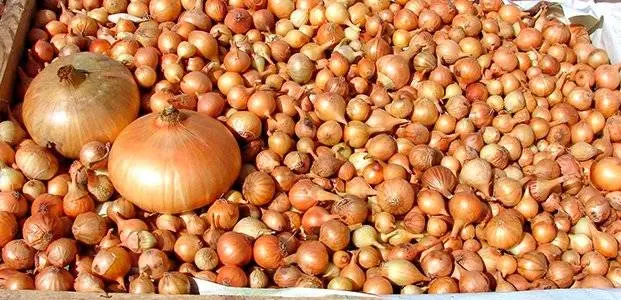
Before planting the seedlings, it is imperative to sort out:
- Remove bulbs with signs of damage, disease.
- Bulbs with a diameter of up to 1,5 cm, choose for growing turnips by autumn planting.
- Seeds with a diameter of 1,5 cm or more can be planted before winter for an early green feather.
For the winter, only selected sevok should be planted. Dry and damaged specimens will not sprout in the spring, which means that the invested work will be wasted and the free areas of the site will have to be sown again in the spring.
The onion selected by external inspection must be prepared in a certain way before planting:
- Warming up the planting material will help to avoid shooting. It is necessary to carry out this event 1-2 weeks before planting the sowing in the ground, at a temperature of +40-+450C for 8-10 hours. You can warm the onion near the heating battery or in the oven, strictly controlling the temperature.
- Disinfection will help remove pest larvae, fungal spores and viruses that are not visible to the eye from the surface of the bulbs. Seed processing should consist of two stages. The first step is to soak the sevok in salt water for 3-4 hours. The salt concentration should be 1 tbsp. l. for 1 liter of pure water. After the saline solution, the planting material must be washed and soaked for 2 hours in a solution of potassium permanganate or copper sulfate.
- Soaking in a solution of the drug “Epin”, “Humate” or “Zircon” will allow the sowing to take root faster, overwinter well and stock up on vital energy for subsequent growth.
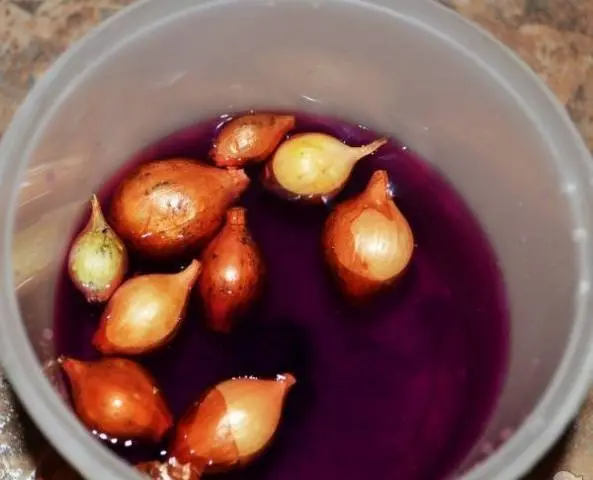
All types of processing must be carried out sequentially. After using disinfectants, the seeds can be washed, dried and stored for some time. Treatment with drugs that stimulate root growth must be carried out immediately before planting. It is not necessary to wash off the active substance from the surface of the bulbs with water before sowing into the ground.
Choosing the best time to sow a crop in the fall
The autumn period is so long and unpredictable that it is impossible to navigate and choose a specific date for sowing onions. Each farmer should decide when to plant onion sets in the fall before winter, depending on the weather conditions in a particular region.
Winter onion sets should be planted at a time when outside daytime temperatures do not rise above +50C. At night, the temperature can drop to -40C. In such conditions, the sevok will take root, but will not give green feathers. Under warmer conditions, the seedlings will begin to grow and die with the onset of frost. If you plant onions at consistently sub-zero temperatures, then they will not have time to take root and will also die in winter. It takes about 40 days to root a sevka. After this time, weather disasters for onions are not terrible.
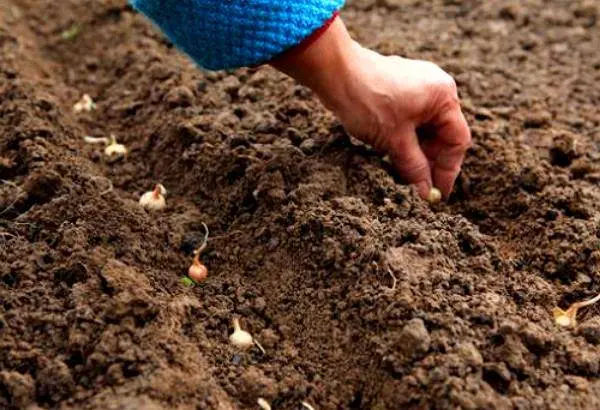
If we analyze the climatic conditions of some regions, then we can give the following advice on the timing of the autumn planting of sevka:
- In the Leningrad region, onions should be planted in early October.
- For the Moscow region, the best time for planting is in mid-October.
- In Volgograd, it is necessary to plant onions in late October – early November.
- Farmers in Western Siberia can start work from mid to late October.
It is worth noting that the proposed dates are not exact, they should be considered as a recommendation and the planting date of the seedlings should be adjusted depending on the forecast weather forecast.
Sub-winter planting of onion sets can be carried out, including taking into account the recommendations of the lunar calendar. It has long been noted that the phase of the Earth’s natural satellite significantly affects the development and growth of plants. So, sowing onion sets in open ground is not recommended during the full moon.
Thus, when choosing the time for planting winter onions, you need to analyze the prospective weather forecast. If no jumps in warming are predicted, and stable frosts will come only in a month, then you need to look into the lunar calendar and proceed to the autumn planting.
Soil preparation for onions
Before planting onion sets before winter, you need to explore your site and choose the most suitable place for growing this crop. It should be well lit by sunlight and protected from strong northerly winds. Onions cannot grow in wetlands. It is preferable to plant onions on a hill, where in spring the water will not linger for a long time after the snow melts.
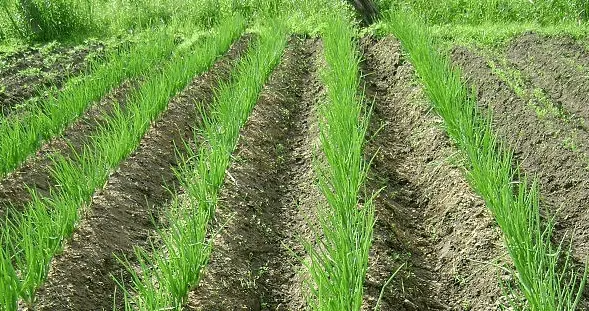
For onions, as for any other crops, good and bad predecessors can be distinguished. So, it is recommended to sow onions in the place where cabbage, greens or radishes used to grow. Cucumbers, tomatoes, potatoes and legumes are also good precursors for onion sets. It is not recommended to grow onions after radishes, celery or carrots.
It is necessary to dig up the bed and prepare the soil 2-3 weeks before planting the onion. During this period, the soil will be compacted, which means that the planted bulbs will not be washed out with melt water with the advent of spring. The soil should be disinfected before the formation of ridges, since various pests in the autumn show an increased interest in fresh sets. Disinfect the soil with a solution of manganese or copper sulfate. If it is decided to use vitriol, then its concentration should be 1 tbsp. l. to a bucket of water. This volume of liquid is sufficient for irrigation of 5 m2 of the soil.
The soil for growing winter onions must not only be loosened and disinfected, but also fertilized. In the fall, you need to make rotted organics and minerals. 1 m2 soil should add 3-5 kg of humus, depending on the initial state of the soil and 2 tbsp. l. double superphosphate. If wood ash is available, you can use it.
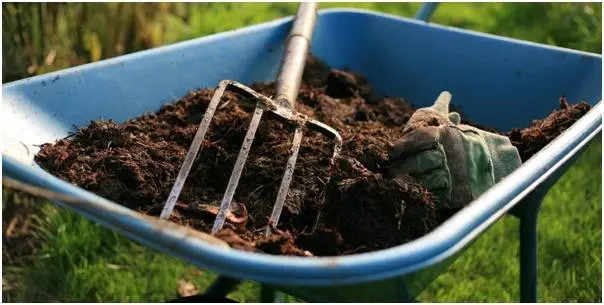
Fertilizers must be evenly distributed over the entire surface of the soil and mixed with garden soil. Form ridges from the resulting substrate and level their surface.
For sowing in the autumn, soil moisture is very important. Therefore, in dry weather, a day before sowing the crop in the ground, it is recommended to thoroughly water the ridges. This once again compacts the soil and creates a favorable environment for building up the root system of the plant.
Important nuances of landing
Not every practicing gardener knows exactly how to properly plant sevok. The procedure, at first glance, is very simple, but it has several important nuances that may not allow growing onions planted for the winter:
- A small set, up to 1,5 cm in diameter, cannot be buried deep into the ground, since in this case it may not germinate. The optimal depth for such planting material is only 2-3 cm.
- A large set grown on a feather must be planted to a depth of 3-4 cm.
- Sevok without soil cover or under a thin layer of it will certainly freeze in winter.
- Onions must be planted in a checkerboard pattern in rows, at a distance of 15-20 cm from each other.
- Between splinters in one row, a distance of 7-10 cm should be maintained.
To understand exactly how to plant onion sets, you can consider the diagram below. It marks all the distances and the chess way of placing planting material in the garden.
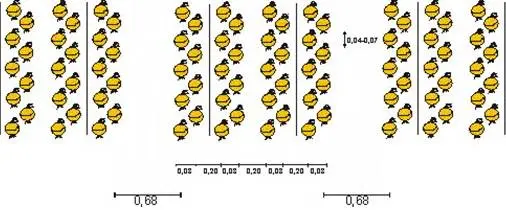
Podzimny sowing sevka must be accompanied by mulching of the ridges. A layer of mulch made from peat, straw, dry leaves will help protect winter onions from frost. The weather is especially terrible for crops, when frosts have already set in, but there is no snow yet. At this time, the mulch will be the only salvation for the young onion.
Mulch in the garden must be maintained throughout the winter period. To prevent strong winds from blowing it away, you can put spruce branches and dry branches on top of the leaves and straw. With the arrival of spring heat, the mulch should be removed from the garden bed so that the soil warms up faster and the seedlings begin to grow.
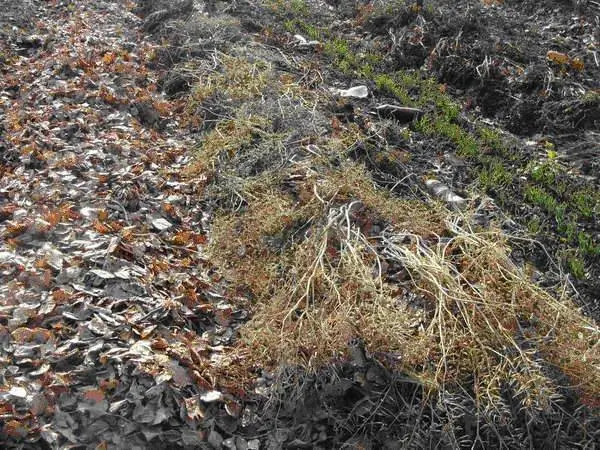
Further care of the culture is standard. It includes regular watering, weeding and loosening the soil. Planting and caring for winter onions is well described in the video:
An experienced specialist in this video will talk about the important advantages of the winter growing method and demonstrate the process of planting winter onions.
Why is it better to sow onions in the fall
Planting in the fall allows the onion to grow and mature at least 2 weeks earlier than spring planting.
In addition to this important advantage, winter-grown onions and the technology itself have other advantages:
- Planting onions before winter is a preventive measure to combat peronosporosis.
- Having planted the seedlings in the fall in the ground, you do not need to take care of the safety of the planting material in the winter.
- In autumn, the gardener has much more free time that can be devoted to planting winter onions.
- It is much more profitable to buy sevok in the fall than in the midst of the spring sowing season.
- Winter onions keep well and for a long time.
- Rooted sevok in winter is resistant to onion flies.
- In winter, only the strongest seedlings are naturally selected. Weak bulbs die out. In their place, in the spring, you can sow a little fresh sevka. At the same time, the planting material preserved from the winter gives the highest quality, fruitful onions.
- With the help of planting before winter, you can significantly increase the yield of the crop.
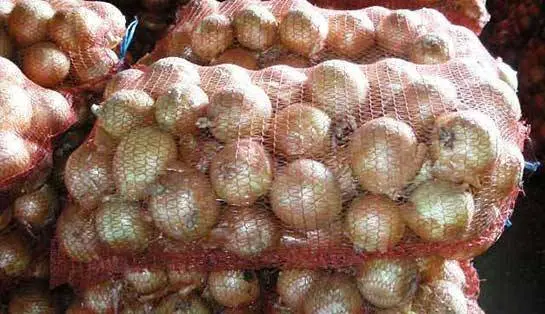
So is it possible to sow onions for the winter? Of course, it is possible and even necessary, because such planting has a number of advantages and allows you to get only the best crop of high quality vegetables. But in order for the work of the farmer to be crowned with success, it is necessary to correctly select a crop variety, accurately determine the time of planting and properly prepare the soil and planting material, and mulch the ridges after sowing the sowing. All these and other nuances of growing winter onions are described in detail in the proposed article above. Subject to all the above rules, even in the northern regions of the country, it will be possible to successfully use the proposed growing method and be content with an excellent onion crop.









